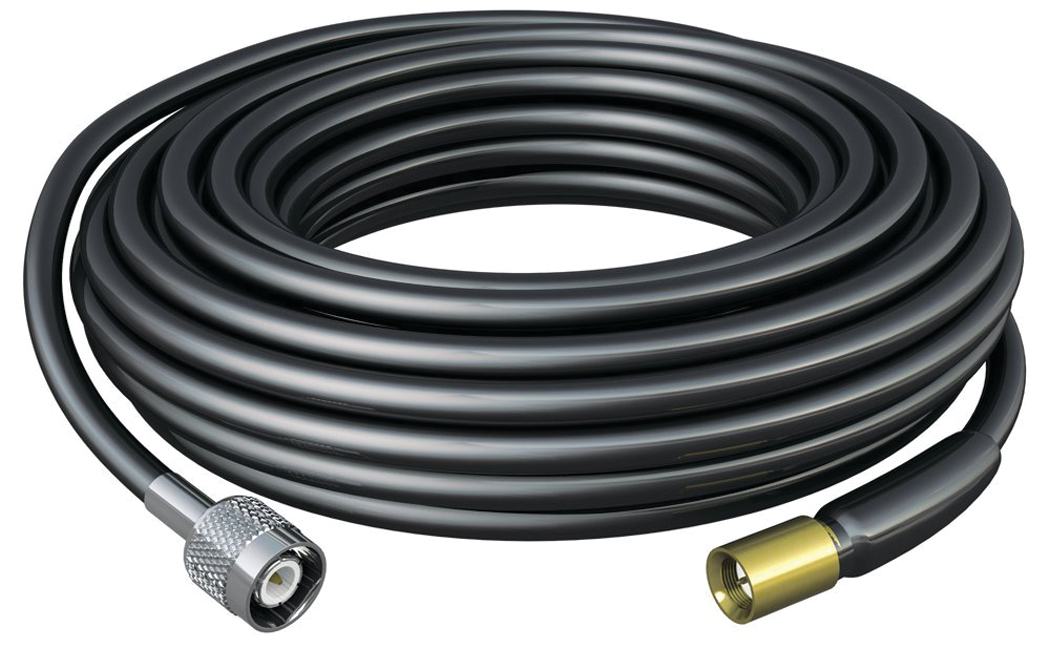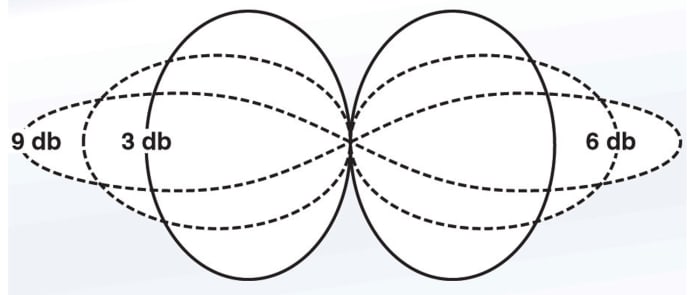Marine Antennas
Deciding on a marine antenna can quickly become a morass of technical jargon – overwhelming even the most knowledgeable boater. But considering that a VHF radio is only as good as the marine electronics antenna that supports it, it's important to understand what you are buying. Below is a simple overview of the main points that boaters should consider when purchasing a marine antenna.
Antenna Length
The height of the antenna plays a crucial role in determining the range of the signal. VHF waves travel in what is known as the line of sight, and the higher the antenna, the farther it can see over the horizon. With this in mind, it is essential to consider the boat and its communication needs when selecting an antenna length.
Sailboats:
Generally, because they have a mast, sailboats have a 3' - 5' antenna mounted at the masthead. Even with their short length and low gain, the height advantage of the masthead mount gives these antennas great range.
Powerboats:
Most powerboats from 16' to 25' in length use a “standard” 8' antenna with an extended frequency range up to 162 MHz for VHF and NOAA Weather, while bigger vessels can have larger antennas with more gain. Be sure to allow room to lay the antenna down, if necessary, for clearing low bridges or covered slips. Your mounting arrangement should also be very sturdy to avoid damage to both the boat and antenna when underway in rough seas. The right accessories for marine antennas are crucial for optimal performance and functionality. For example, when choosing a marine digital antenna, it is important to consider the type of connector used. A Marine Fiberglass VHF Antenna with a molded PL 259 connector is a popular choice among boaters due to its durability and compatibility with Cobra Marine and all other VHF radios.
Antenna Gain (Db and Mhz)
After placing the antenna as high as practical, the next way to increase the range of your radio installation is to increase the gain of your antenna. Gain is measured in decibels (dB); generally speaking, the higher the gain, the greater the range. Marine antennas don't radiate energy equally in all directions – the signal “beam” is concentrated in the horizontal plane, parallel to the water. Gain can be thought of as a measure of the “focus” of this beam and its available energy. The energy travels further if the focus is narrow (high dB), like a lighthouse. However, a narrowly focused signal beam may rise above or fall below the intended target in heavy seas, causing signal loss or fading. Although lower gain antennas have a less focused signal and a shorter range, boats that roll or heel significantly often install them to ensure that some portion of the signal beam always points toward the target antenna, even when heeled or rolling.
9 db 3 db 6 db
Typical Radiation Patterns
(Radiating antenna is at center; horizontal axis of diagram is parallel to the water's surface; boat is not heeled.)
Increased gain ratings almost always mean taller antennas. The structural integrity of the mounting installation and the antenna itself must be balanced against the quest for greater range. Sailboats and small, lightweight powerboats, which roll excessively in heavy seas, normally do not use long antennas with gain ratings above 6dB. The more stable the platform of a vessel, the higher the gain that can effectively be used. For boats ranging from 20 to 35 feet in length, it is recommended to use an 8-foot, 6dB antenna. This type of antenna provides less range than a 9 dB antenna, but it is also less susceptible to the effects of pitch and roll.
Mounts
There are many styles of mounts available to suit your particular application and support needs. An upper support clamp is necessary if you are using a two-piece antenna system greater than 10' in length. For antennas 14' to 18', the upper clamp should be 3' to 5' from the bottom. For antennas of 18' to 23', the upper clamp should be 4' to 8' from the bottom. Positioning the upper clamp too high or too low can significantly increase the potential for structural failure, so it's important to get this right.
Cable (is coax better?)
The cable you choose can make or break your VHF system. There is nothing more frustrating than having a great radio and a great antenna, only to have terrible range because you choose the wrong type of coax cable for the length of your cable run. RG-58 coax cable is sufficient for cable runs up to 20'. For runs over 20', larger and better, low-loss RG-8X or RG-213 is preferable to ensure minimal corrosion and maximum signal transmission.
For optimum performance, the cable connection should be kept as short as possible, and the connections should be high quality and as few in number as possible. If you have to make a new connection, you must use high-quality fittings and install them correctly. A poor connection can lower your transmitting power by a factor of 10 or more, so take the time to do this right.
Low Angle Radiation
While phased 1/2-wave collinear elements are the standard in high performance, high gain antennas, collinear phased 5/8-wave antennas, such as those made by Shakespeare, offer an increased level of performance by concentrating the radiated signal closer to the horizon, allowing for minimized fading and increased range, even during excessive vessel roll in turbulent seas. This is something you should look for when selecting a fiberglass VHF antenna. The Shakespeare VHF marine antennas, such as the Classic, Galaxy, and Phase III models, are known for their superior performance. These antennas are designed with a combination of coaxial cable, brass, stainless steel, and copper to ensure maximum efficiency. The digital antenna is an excellent choice for marine applications due to its advanced technology and reliable signal reception capabilities.
 What to Buy
What to Buy
So, which antenna should you choose? Fisheries Supply features Shakespeare antennas, representing the highest quality and most advanced antenna technology on the market. When looking at Shakespeare antennas, we recommend you consider a Good/Better/Best concept and buy the best antenna your budget can afford.
- For a “Good” antenna, choose from their Classic Series, which provides quality performance for a reasonable price. These antennas are designed to provide basic communication and navigation capabilities for the widest variety of vessels.
- Shakespeare's Galaxy Series is the next step up and has long been revered as the industry standard for both performance and beauty with top-notch materials and hand assembly. These “Better” antennas can be relied upon for high performance and extra durable construction, along with the high-end electronic features in a high-quality, but fairly priced, antenna.
- But when only the “Best” will do, Shakespeare's Phase III Series features the most sophisticated electrical engineering levels, performance, and durability available today. These extra heavy-duty antennas are completely foam-filled (which isolates the radiators from vibration and moisture – helping the antenna last longer), have silver-plated elements (that actually improve with age), and stranded, high-quality tinned copper inner conductors, which maximize signal strength. These high-strength fiberglass antennas with aircraft-grade coatings that ensure a high-gloss, non-yellowing protective finish, are unsurpassed in the industry.
What is the difference between VHF and UHF marine antennas?
VHF antenna signals operate at a lower frequency, with longer transmission waves – meaning the waves can travel longer distances, even following the curve of the earth – but the signal will generally not pass through structures. This makes VHF perfect for outdoor needs, such as calling boat to boat out on the open water, but not so good for metropolitan areas with lots of structures that would break up the transmission signal.
UHF antenna signals operate at higher frequencies with much shorter wavelengths – so while they don’t travel nearly as far (more of a straight line), they pack more punch in the quality of the signal and can penetrate structures – making them better for indoor or urban needs where there are more things to interrupt the wavelength. It’s worth noting that VHF antennas tend to be quite large and bulky – making them less portable in general, while UHF antennas can be very small – making them more portable. Also note that in most cases, these two signals cannot work together as they operate in very different frequency ranges.
Are there any maintenance tips for keeping my marine antenna in good condition?
To keep your marine antenna in good condition, regularly inspect it for any signs of damage or corrosion. Clean the antenna regularly with a mild soap and water solution, and avoid using abrasive materials. Additionally, ensure that all connections are secure and tighten any loose components as needed.
We hope this has helped you choose the right antenna for your boat to make your VHF radio installation the best it can be. Buying a marine radio antenna or figuring out marine VHF antenna types can be intimidating. There are a lot of factors to determine the best marine VHF antenna, antenna mounts or correct VHF antenna length. Product reviews help, but if you still have questions or need more help, feel free to contact our product experts at (800) 426-6930.


